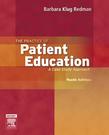患者教育实践
2006-6
Elsevier Science Health Science div
Redman, Barbara Klug
157
With patients leaving the hospital sicker and more care being done in outpatient settings or at home, patients need to become active, informed participants on their health care team. This one-of-a-kind text provides unique advice to help nurses apply their knowledge and skills to teaching patients in the clinical setting with specific diseases, including special populations. The book is organized into two basic sections - the first describes the theories and process of learning and teaching, and the second focuses on the major fields of patient education practice in place today. The new case study approach also makes it easy for students to understand how to apply teaching strategies to specific patient types resulting in better informed patients and a more positive teaching/learning experience. Covers a variety of learning theories and concepts, as well as strategies for applying them in patient teaching. Uses evidence-based patient education practice, with extensive citations to the research base. Presents key issues in patient education such as literacy, use of patient decision aids, and multiple patient conditions for which organized patient education should be developed.Includes study questions with suggested answers. Teaching basics streamlined for use as the main text for a course or as a supplement to any clinically oriented course. Includes multiple case examples, at every stage of the teaching process, which students can use as models to guide their own practice. New case study approach provides multiple case examples enabling readers to understand how to apply teaching strategies to specific patient types and settings. Now includes significant content in patient self-management of chronic conditions, the largest growing area of patient education.
1 The Practice of Patient Education: Overview, Motivation, and Learning The Process of Patient Education Motivation, Health Beher Model Tanstheoretical Model Motivational Interviewing Learning Theories of Learning Types of Learning Developmental Phases2 Educational Objectives and Instruction Educational Objectives Instructional Forms Interpersonal Teaching Forms Role Playing Demonstration and Practice Teaching Tools Screening, Preparing, and Testing Teaching Materials Planning and Implementing Instruction3 Evaluation in Patient Education Obtaining Measures of Behavior Rating Scales and Checklists, Oral Questioning Written Measurement Evaluative Judgments4 Cancer Patient Education General Approach Educational Approaches Community-Based Education and Education of Special Populations5 Cardiovascular and Pulmonary Patient Education Cardiovascular Patient Education Educational Approaches and Research Base Congestive Heart Failure Self-Management Education Stroke Pulmonary Patient Education Chronic Obstructive Pulmonary Disease Adults with Asthma6 Diabetes Self-Management Education General Approach Educational Approaches and Research Base7 Education for Pregnancy and Parenting and Educating Children Education for Pregnancy and Parenting General Approach National Standards and Testing Programs Educating Children General Approach Educational Approaches and Research Base8 Other Areas of Patient Education Practice Rheumatic Diseases Mental Health Preprocedure and Postprocedure Education Women's Health Patient Education9 Patient Education Delivery, Health Policy, and New Directions Delivery of Patient Education Important Policy Issues New Areas of Patient EducationAppendixes A Suggested Answers to Study Questions B Additional Study Aids
